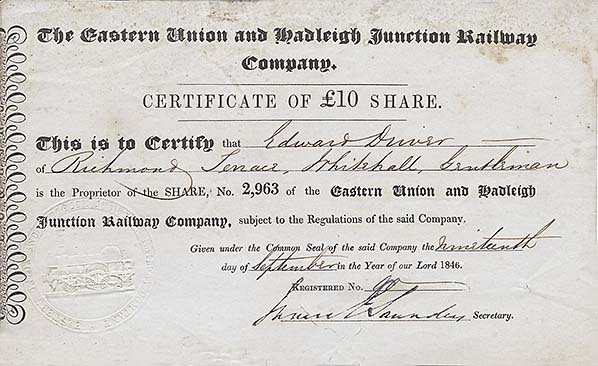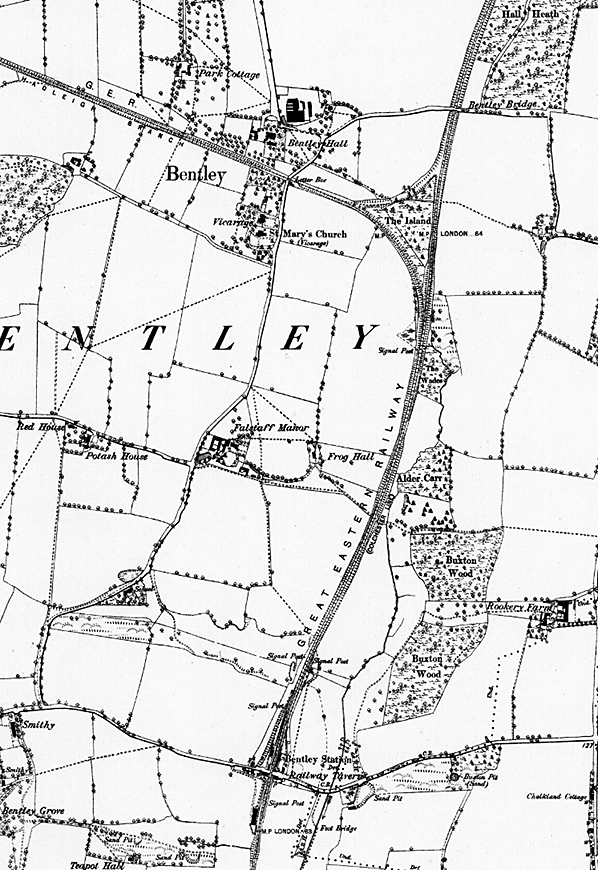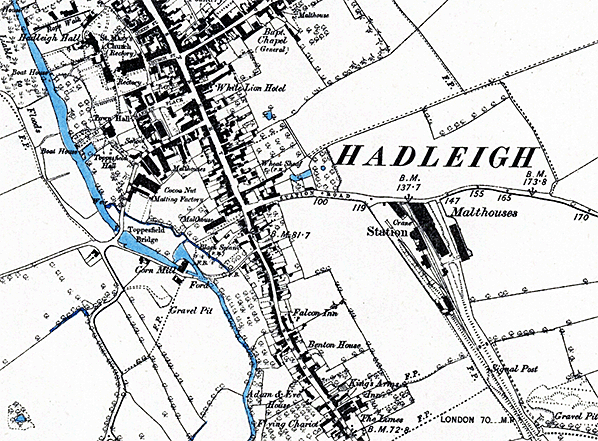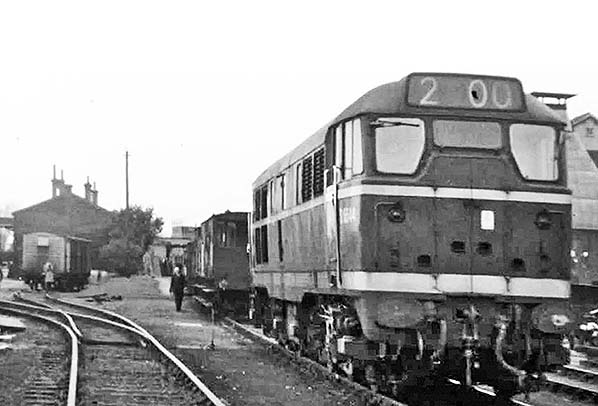
A BRIEF HISTORY OF THE HADLEIGH BRANCH[Source:Nick Catford} At the time of the earliest railways, the town of Hadleigh was an important centre of the wool and clothing industry. The Eastern Counties Railway was incorporated in 1836 to build a railway from London to Yarmouth; the capital was £1.6 million. This was a prodigious project, and in fact the actual cost greatly overran, so that all the money was spent and the railway only reached Colchester. When the ECR reappraised its plans, it proposed to build from Colchester to Bury St Edmunds through Hadleigh, putting Ipswich on a branch from the town, but this scheme came to nothing. Local interests were dismayed that their railway connections were to be denied to them, and in 1844 the Eastern Union Railway was incorporated, to build from Ipswich to Colchester, and possibly to include Norwich in its network. However this line was not to connect to Hadleigh, and by that date merchants in the town had seen the adverse effect on formerly prosperous towns that were by-passed by main lines. Local people were concerned that the town would be left isolated, 7 miles from the nearest railhead at Bentley, and as a result would suffer a loss of trade. A group of local businessmen, led by Rowland Hill (not the postal reformer), promoted a branch line scheme to connect Hadleigh with Bentley station on the Eastern Union Railway main line, seven miles away. There was intense competition between the Eastern Union Railway and the rival Eastern Counties Railway: the object was to capture as much territory as possible. From the EUR point of view, the Hadleigh branch would cut off the possible advance of the ECR. Accordingly the EUR supported the local scheme, which was nevertheless promoted in Parliament as an independent project. The Eastern Union and Hadleigh Junction Railway was incorporated by Act of 18 June 1846; the share capital was to be £75,000 made up of 7,500 £10 shares (see below). A number of the directors were also directors of the Eastern Union Railway, these included John Chevallier Cobbold (Chairman of the EUR), his father John Cobbold and James Allen Ransome (Vice-chairman of the EUR). The Act authorised a triangular junction with the Eastern Union at Bentley. It was to be built as a single track, but sufficient land should be purchased for double track with bridges being built for double track in case the line was doubled at a later date. Three years were allowed for acquiring land with the line to be completed within four years. The length of the line was just under 6½ miles, with few earthworks, and six level crossings, three road under-bridges and one over. Most of the line was level with about 2½ miles at 1 in 132. After leaving the main line the branch would pass through Bentley, Copdock, Capel St Mary, Little Wenham, Great Wenham, and Raydon to terminate in Hadleigh.
Eastern Union Main Line Opens The Eastern Union Railway had opened its main line for goods traffic on 1 June 1846, and passenger operation started on 15 June 1846. The EUR wasted no time in indicating a wish to bring the EU&HJR company into its own control, and the EU&HJR was amenable. When the contract for construction was to be let, the EUR Board were invited to ratify it. Peter Bruff was the engineer for the EUR main line and he agreed to act in the same capacity for the promoters of the Hadleigh branch as well. The contractor selected was George Wythes. He agreed to construct the line and lay the track for £51,700. The EU&HJR directors considered that an extension of their line to Lavenham, an important town in the wool industry, was desirable, and they put in hand the necessary measures to secure Parliamentary authorisation for that. The extension to Lavenham was to be engineered under Bruff’s direction. It headed from Hadleigh north-west to Kersey and Semer, then west to Brent Eleigh and Lavenham, where it would have had a junction with the proposed extension of the Stour Valley line. The EUR was, at the same time, encouraging the Colchester, Stour Valley, Sudbury and Halstead Railway, which had just received its authorising Act. The Lavenham extension would conflict with the strategic objectives of the EUR, and they asked the EU&HJR to defer their proposal. At first the local company declined to do so, but they were later persuaded to relent and the extension was eventually dropped altogether but not before a Bill had been put before Parliament.
First sod cut on the Hadleigh branch The ceremony of the cutting of the first sod of the Hadleigh Railway took place on Saturday 5 September1846, on land near Raydon Wood. Construction of the line began in November 1846 and proceeded quite rapidly with a team of 200 - 300 navvies. Construction wasn’t as straight forward as had been expected. Boggy land near Bentley and at Raydon had to be drained. The heaviest earthwork involved the crossing of a minor stream at Raydon Bottom. The Suffolk Chronicle reported a 50 ft high embankment, the highest in Suffolk. There were several cuttings with one between Raydon and Hadleigh being 38 feet deep. Construction was slowed in early 1847 due to bad weather but once that improved, work continued at a good pace with the first rails being laid in mid-March. By the end of April the permanent way had reached a point ¾ mile from the junction at Bentley and was approaching the site of Capel station. A special inspection was made on Saturday 1 May when a train comprising a locomotive and two carriages ran from Ipswich to Bentley and then along the branch to the end of the track. The party alighted and walked the rest of the track bed to Hadleigh. The Act authorising amalgamation of the EU&HJR with the EUR was passed in the following session of Parliament, on 8 June 1847
By the end of July only some final ballasting was required. Confident in the timely completion of the line, the directors arranged a ceremonial opening on 20 August 1847. A special train comprising four first class, six second class and two open coaches, or three saloons, two first class and four second class coaches (depending on which newspaper report you read), hauled by the locomotive Hadleigh, left Ipswich station at 3.25 pm. Dignitaries included members of the EUR board, engineer Peter Bruff and many shareholders. The Humpress Band sat in the open vehicles at the rear. Crowds gathered at the intermediate stations where exploding detonators greeted the train. It pulled in to Hadleigh, where a public holiday had been declared, at 4.15; the firing of a cannon celebrating the opening of the line. A procession, led by the Hadleigh Town Band, made its way to the Town Hall for a celebration dinner.
The following day the line opened to goods traffic. The Board of Trade inspection, essential for passenger operation, had not taken place, and the line could not yet be opened to passengers. Captain J L A Simmons conducted the inspection on 30 August 1847. Simmons report noted that the junction at Bentley was a triangle so that trains from Ipswich could run direct to the branch. Simmons was satisfied and the line opened fully on Thursday 2 September 1847. Intermediate stations were provided at Capel and Raydon. There is some debate as to whether there was an additional intermediate station at Bentley Church west of the triangular junction with the main line. It could have been used as an alternative station to Bentley for trains running from Ipswich using the north curve. It appeared in timetables in October 1853. In reality the north curve was rarely used and the appearance of the station in timetables may have been premature and it was not shown after December 1853.
Service on the Hadleigh branch
In 1848 two direct services to Ipswich were included in the schedule each weekday, but the northern section of the triangular junction to the main line was closed in 1875. From that time, any services to Ipswich reversed at Bentley. Some through coaches to London were run. In 1875 and 1876 in the return direction they were slipped at Bentley and attached to a local train. The 1874 timetable showed a slight improvement to four return journeys each weekday, with trains from Hadleigh at 8.10am and 10.10am, 1.13pm and 5.23pm, returning from Bentley at 9.0am and 10.50am, and 2.0pm and 6.17pm. In 1889 there were five passenger trains each way per day on the line, with some working through to Manningtree. The Great Eastern Railway was formed in 1862 by the amalgamation of the Eastern Union Railway, the Eastern Counties Railway and others. The effective date was July 1862.
In summer 1913 further improvements in the service had taken place, so that the 7.53am and 9.12am up from Hadleigh ran each weekday, together with the 12.33pm and 5.35pm mixed. On Tuesdays and Saturdays there was a 7pm up, and on Tuesdays only a 2.58pm through train to Ipswich, reaching there at 3.35pm, returning at 4.17pm and arriving in Hadleigh at 4.47pm. Other down services left Bentley at 8.33am (mixed), 9.42am, 1.47pm and 7.27pm, plus 6.27pm on Tuesdays and Saturdays, and the extra trains on Tuesdays were run in connection with the corn and cattle markets at Ipswich.
Passenger services on the line peaked in 1920 when the number daily had reached seven. The conductor-guard system was introduced in the Spring of 1922 in an attempt to reduce costs of passenger train working. The Railways Act 1921 required most of the railways of Great Britain to be placed under the ownership of one or other of four new large concerns, in a process known as the ‘grouping’. The Great Eastern Railway was a constituent of the new London and North Eastern Railway (LNER); the transfer is considered to have taken effect from the beginning of 1923. Competition from bus services reduced the service to five a day by 1924, which was the level maintained until passenger service was withdrawn. The signal boxes at Capel and Raydon Wood were closed and associated signalling was removed as the line now operated with ‘one engine in steam’. The intermediate stations were now served by booked calls only, which brought a slightly shorter journey time of about 21 minutes to Hadleigh, but 19 minutes up to Bentley. The low passenger numbers on the line were not overlooked by the LNER and following a 7-day railway strike in 1924 and further disruption to the service during the general strike in 1926, it was announced that the passenger service on the line would be discontinued after the last train on 27 February 1932; the line was closed to passengers from 29 February 1932. The guard on the final day’s service was Mr S. W. Westwood.
The line remained open for goods and parcels traffic, and it was advertised that special excursion trains would be run as necessary from Ipswich. Passenger services were to be provided by the Eastern Counties Omnibus Company Ltd, whose route to Ipswich was much more direct than by rail. Goods traffic was relatively light at the intermediate stations. In 1913, apart from the mixed workings, there were trains from Bentley at 7.05am on Tuesdays only when required, and 3.55pm, not Tuesdays. In the up direction they left Hadleigh at 6.35am on Tuesdays only if required, running as an express cattle train, and 2.50pm, Tuesdays excepted; Capel and Raydon Wood were served as required. This remained the case in 1937, when the 8.22am from Bentley started at 7am from Ipswich, and reached Hadleigh at 8.50am. The engine and brake van returned almost immediately (at 9.15am) to Bentley and then worked the 10.40am to Mistley, on the Harwich branch. They were allowed to work important traffic up the branch if necessary. Another goods working left Bentley at 3.05pm, reached Hadleigh at 3.40pm, and left again at 5.15pm; having done the necessary shunting at the terminus, this train then worked back to Ipswich. The goods facilities at Capel and Raydon Wood were used extensively during World War II, handling supplies for a nearby United States Army Air Forces base, later becoming RAF Raydon. In peacetime the goods service on the line resumed its decline. The pattern in 1956 was broadly the same as pre-war, with the 7.28am from Ipswich leaving Bentley at 8.20am and reaching Hadleigh at 9.05am. It left at 10.15am, reaching Bentley at 10.50 and not leaving until 12.07pm for Manningtree. In the afternoon, the train left Manningtree at 2.25pm and reached Hadleigh at 3.35pm, leaving at 4.24pm for Ipswich. Passenger trains had been generally worked by one of the smaller tank engines, although tender classes were usual on goods trains. These included ‘J 15s’ and ‘J 17s’, and ‘E4’ No 62797 turned up on an enthusiasts’ excursion on at least one occasion. Latterly various types of diesel locomotive were used on the line, including what are now Classes 20*and 31. Capel closed to public traffic earlier than the others, from 13 July 1964, goods facilities at Bentley being withdrawn at the same time. Raydon Wood and Hadleigh saw their last trains on Thursday 15 April 1965, the final service being the 12.30pm from Ipswich hauled by Class 31 No D5699. Officially closure took place from 19 April 1965. The track was removed later that year. Bentley station lost its passenger service on 7 November 1966.
Today part of the route of the Hadleigh branch is available to walkers and cyclists. The Hadleigh Railway Walk follows line from Hadleigh to Raydon Wood station. It's a 2 mile stroll on flat paths. The walk starts in Station Road, Hadleigh, close to the centre of the ancient market town. The route heads south east along the old line, passing Raydon Great Wood before finishing at Raydon Wood station. Both Hadleigh and Raydon Wood stations can still be seen. There's a car park at this end of the route. Ticket from Brian Pask SOURCES
Route map drawn by Alan Young. Braqdshaw from Alan Young. Ticket from Briak Pask. To see the
stations on the Hadleigh Branch click on the station name: Bentley, Bentley Church, Capel, Raydon Wood & Hadleigh
|
 From Ian Dinmore /
From Ian Dinmore /  1887 1:10560 map showing Bentley station and Bentley junction. The north curve had already been lifted by this time.
1887 1:10560 map showing Bentley station and Bentley junction. The north curve had already been lifted by this time./route_map.gif)

 In January 1959 a leaky Class J17 0-6-0 No. 65578 is seen in the sidings at Bentley. The precise location is difficult to determine but the short bracket signals and apparent slight track curvature suggests it is close to Bentley Junction signal box, on the Down side of the main line. Also unclear is what the locomotive is working. The Hadleigh goods, on certain days, left some of its train at Bentley and proceeded to undertake a goods working on the Harwich branch before returning to Ipswich, collecting the ex-Hadleigh wagons at Bentley along the way. Perhaps this is what No. 65578 was doing when photographed. The Harwich trip was possibly the reason why the Hadleigh goods sometimes had a brake van at both ends, to simplify shunting at Bentley. No. 65578 began life in 1900 as Great Eastern Railway No. 1228. Withdrawn in March 1962 she was an Ipswich resident between November 1950 and December 1959. Her tender carries the British Railways device introduced in 1956.
In January 1959 a leaky Class J17 0-6-0 No. 65578 is seen in the sidings at Bentley. The precise location is difficult to determine but the short bracket signals and apparent slight track curvature suggests it is close to Bentley Junction signal box, on the Down side of the main line. Also unclear is what the locomotive is working. The Hadleigh goods, on certain days, left some of its train at Bentley and proceeded to undertake a goods working on the Harwich branch before returning to Ipswich, collecting the ex-Hadleigh wagons at Bentley along the way. Perhaps this is what No. 65578 was doing when photographed. The Harwich trip was possibly the reason why the Hadleigh goods sometimes had a brake van at both ends, to simplify shunting at Bentley. No. 65578 began life in 1900 as Great Eastern Railway No. 1228. Withdrawn in March 1962 she was an Ipswich resident between November 1950 and December 1959. Her tender carries the British Railways device introduced in 1956. The line was worked by the Eastern Union from the outset. Initially the new service proved popular with local people and passenger traffic was heavy with five trains in each direction on weekdays and three on Sundays. Due to a lack of passengers the Sunday service was soon withdrawn. The initial euphoria was, however, short lived with the 1860 timetable showing three trains each way on Mondays to Saturdays. They left Hadleigh at 8.15am, 12.55pm and 5.25pm, returning from Bentley at 10.55am, 2.10pm and 6.10pm; the running time was 25 minutes. There was no Sunday service. The profitability of the line was by now disappointing.
The line was worked by the Eastern Union from the outset. Initially the new service proved popular with local people and passenger traffic was heavy with five trains in each direction on weekdays and three on Sundays. Due to a lack of passengers the Sunday service was soon withdrawn. The initial euphoria was, however, short lived with the 1860 timetable showing three trains each way on Mondays to Saturdays. They left Hadleigh at 8.15am, 12.55pm and 5.25pm, returning from Bentley at 10.55am, 2.10pm and 6.10pm; the running time was 25 minutes. There was no Sunday service. The profitability of the line was by now disappointing. Road traffic at Capel's A12 level crossing waits while the Hadleigh goods makes its way back towards Bentley. This was prior to the level crossing gates being fitted with various embellishments designed, not always successfully, to make the crossing's presence more obvious to road vehicle drivers. The locomotive is a BR/Sulzer Type 2, later Class 24. With the passage of time it is easy forget these locomotives were once common in the southern half of East Anglia. Commencing in August 1959 Ipswich depot had a large number of the type but the last examples were allocated away from the area in 1967. They could also once be found at Finsbury Park depot, working goods and occasional passenger trains on the King's Cross suburban lines. The lorry nearest the camera appears to be carrying bags of cement and although some strapping is evident the load does not seem particularly secure. The car is a Hillman Minx Mk III estate, this particular model being introduced in 1949 with the example pictured being first registered during November 1955 in Norwich.
Road traffic at Capel's A12 level crossing waits while the Hadleigh goods makes its way back towards Bentley. This was prior to the level crossing gates being fitted with various embellishments designed, not always successfully, to make the crossing's presence more obvious to road vehicle drivers. The locomotive is a BR/Sulzer Type 2, later Class 24. With the passage of time it is easy forget these locomotives were once common in the southern half of East Anglia. Commencing in August 1959 Ipswich depot had a large number of the type but the last examples were allocated away from the area in 1967. They could also once be found at Finsbury Park depot, working goods and occasional passenger trains on the King's Cross suburban lines. The lorry nearest the camera appears to be carrying bags of cement and although some strapping is evident the load does not seem particularly secure. The car is a Hillman Minx Mk III estate, this particular model being introduced in 1949 with the example pictured being first registered during November 1955 in Norwich.  Goods traffic on the branch was the normal trade of country town and its rural hinterland comprising coal, feedstuffs and so on. There were several orchards in the area, and the town had a number of corn mills, as well as malting factories. Much of the originating traffic at Hadleigh was connected with the maltings, and amounted to 1,142 tons of grain in 1938, worth £926 to the LNER. In addition, 179 tons of livestock were shipped through the station, with a gross revenue of £284, mostly going to Ipswich market.
Goods traffic on the branch was the normal trade of country town and its rural hinterland comprising coal, feedstuffs and so on. There were several orchards in the area, and the town had a number of corn mills, as well as malting factories. Much of the originating traffic at Hadleigh was connected with the maltings, and amounted to 1,142 tons of grain in 1938, worth £926 to the LNER. In addition, 179 tons of livestock were shipped through the station, with a gross revenue of £284, mostly going to Ipswich market. 1884 1:10560 OS map. Hadleigh station was ideally sited for the extension to Lavenham.
1884 1:10560 OS map. Hadleigh station was ideally sited for the extension to Lavenham.

 Home Page
Home Page